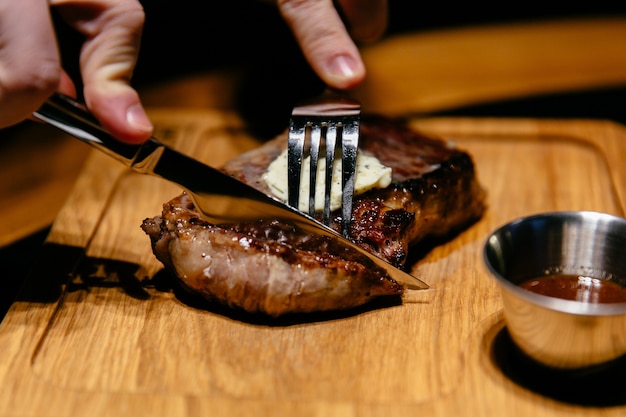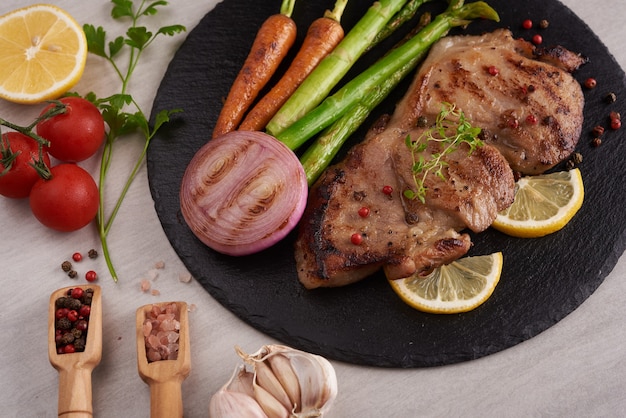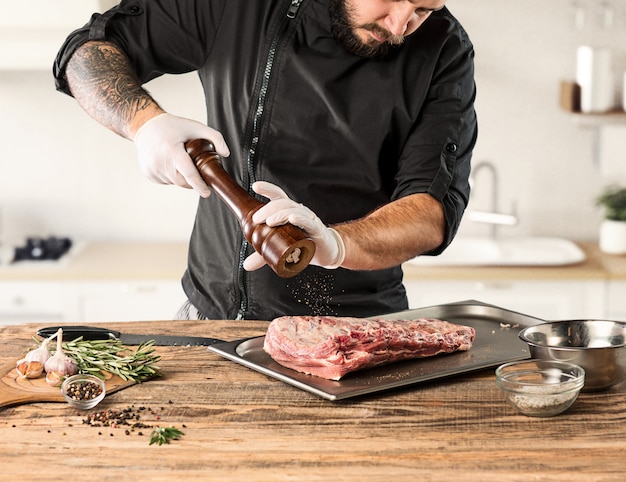I’ve always been a bit of a pork steak enthusiast. There’s something so satisfying about a perfectly cooked pork steak – tender, juicy, and bursting with flavour. But, I’ll be honest, I've had my fair share of dry, tough pork steaks in the past. It took me a while to figure out what I was doing wrong. But now, I'm ready to share all my secrets with you, my friends, because nobody deserves to suffer through another dry pork steak again!
(Part 1) Choosing the Right Pork Steak

It all starts with selecting the right cut. You know, a cut that’s going to be juicy and flavorful. Forget those lean, thin pork chops – we’re going for something with a bit more substance. Let’s talk about how to find the perfect pork steak:
1.1. The Pork Cut: Understanding the Options
First things first, the cut. I’ve found that pork loin steaks and pork shoulder steaks are the absolute best for juicy results. These cuts have just the right amount of fat marbling to keep them moist and tender. I usually look for steaks that are at least an inch thick, and even better if they’re closer to 1.5 inches. You can also find “pork tenderloin steaks” at some butchers, but remember, they are a little more delicate than the other cuts, so they need a slightly different approach. Just be aware of what you’re getting.
1.2. The Colour: A Visual Guide to Freshness
Now, let’s talk colour. You want a steak that's a nice, even pink colour. Avoid anything that looks pale or dry, or has a strong, unpleasant odour. A fresh pork steak will have a bright, slightly sweet aroma. And don’t be afraid to ask the butcher for their recommendations. A good butcher will always be happy to help you find the perfect cut for your needs.
1.3. The Touch Test: Feeling for Quality
Finally, don’t be afraid to give the steak a little squeeze. It should feel firm and springy, not soft or mushy. If the steak feels too soft, it might not be as fresh as you’d like. Remember, a good pork steak should feel substantial and have a nice, firm texture.
(Part 2) Prepping the Pork Steak: Setting the Stage for Success

Okay, so you’ve got your beautiful pork steak. Now it’s time to prep it for cooking. This is where we get into the nitty-gritty of achieving that perfect, juicy result. Here’s the rundown:
2.1. Getting Rid of Excess Moisture: Why It Matters
You see, excess moisture can lead to a dry steak. So, before we start cooking, it’s important to pat your steak dry with paper towels. This helps ensure that the steak browns properly, creating a lovely crispy crust. It also helps to prevent steam from forming during cooking, which can make the steak soggy.
2.2. The Art of Salting: Enhancing Flavor and Tenderness
Now, it’s time to get into the seasoning. And here’s my big tip – don’t be afraid to salt your pork steak liberally. Salt draws out the moisture, but it also helps to season the meat deeply. I like to salt the steak about 30 minutes before cooking. This gives the salt enough time to penetrate the meat. You can also add a sprinkle of black pepper if you like, and if you want to get a bit more adventurous, try adding a pinch of paprika, cumin, or garlic powder. But remember, a little goes a long way.
2.3. The Importance of Resting: Giving the Steak Time to Relax
One more crucial step before cooking - let your steak rest at room temperature for about 15-20 minutes. This helps the steak come to a more even temperature, ensuring that it cooks more evenly. It also allows the flavours to develop more fully.
(Part 3) The Magic of Temperature: Ensuring Safety and Juiciness

This is where things get really interesting. The key to a juicy pork steak is cooking it to the right temperature. No one wants a dry, overcooked piece of meat, but you need to ensure it's safe to eat.
3.1. Know Your Temperature: The Safe Zone for Pork
According to the Food Standards Agency, pork should be cooked to an internal temperature of 71°C (160°F). This ensures that any harmful bacteria are killed. But, here’s the thing – cooking to the exact temperature can be a bit tricky. You can use a meat thermometer, of course, which is the most accurate method. But, if you don’t have one, there are some visual cues to look for. The meat will become firm to the touch, and the juices will run clear when pierced with a knife. And remember, it’s always better to err on the side of caution, so it's perfectly okay to cook it a little longer if you’re not sure.
3.2. Resting Time: Unlocking Tenderness and Flavor
Once the steak is cooked to your liking, it’s important to let it rest. Give it at least 5 minutes, but 10 minutes is even better. This allows the juices to redistribute throughout the steak, resulting in a more tender and juicy final product. Think of it as a final touch of magic, before you get to enjoy your masterpiece.
(Part 4) Your Pork steak cooking Options: Choosing the Right Method for You
So, you’ve got the right cut, you’ve prepped it, and you know the importance of temperature. Now, let’s dive into the cooking methods that will bring your juicy pork steak dreams to life.
4.1. Pan-Seared Perfection: A Classic Technique
This is a simple, reliable method that works wonders. Heat a large, heavy-bottomed pan over medium-high heat. Add a little oil to the pan and let it get nice and hot. Then, gently place your pork steak in the pan, making sure it doesn’t overcrowd the pan. Cook the steak for 3-4 minutes per side, or until it has a lovely golden brown crust. Then, reduce the heat to medium-low, and continue cooking the steak for another 5-7 minutes per side, or until it reaches the desired temperature. This method gives you a crispy crust and a juicy, tender interior.
4.2. The Grill Master's Choice: Outdoor Flavor and Texture
Ah, the grill. It’s a summer classic! Preheat your grill to medium-high heat. You want those grill marks, right? So, once the grill is hot, place your steak on the grill and cook for 4-5 minutes per side. Then, move the steak to a cooler part of the grill or turn the heat down, and continue cooking for another 10-15 minutes, or until the steak reaches the desired temperature. This method gives your steak a lovely smoky flavour and those gorgeous grill marks. Don’t forget to use a meat thermometer, as it can be tricky to judge the temperature on a grill.
4.3. The Oven's Gentle Touch: Even Cooking for a Crowd
If you’re not into the high heat of the grill or pan, the oven is a great option. Preheat your oven to 190°C (375°F). Place the steak on a baking sheet lined with parchment paper. Roast for 20-25 minutes, or until the steak reaches the desired temperature. This method is perfect for those who like a more evenly cooked steak. If you want to get fancy, you can baste the steak with some butter, herbs, or garlic during cooking. This will add extra flavour and moisture.
(Part 5) Glazing for Extra Magic: Adding a Touch of Sweetness and Savouriness
We’ve talked about the basics, but what about taking your pork steak to the next level? Glazing is a simple way to add an extra layer of flavour and visual appeal. You can use a store-bought glaze, or try whipping up your own. Here are a few ideas:
5.1. Sweet and Savoury Glazes: Blending Sweetness with Saltiness
For a sweet and savoury glaze, try a combination of honey, soy sauce, and a touch of ginger. Or, if you’re feeling adventurous, try a balsamic glaze with a hint of garlic. These glazes create a delicious, sticky coating that complements the flavour of the pork perfectly.
5.2. Fruit-Based Delights: Adding Bright, Tangy Flavors
For a fruity glaze, try a combination of apple cider, brown sugar, and cinnamon. Or, if you want something a bit more tart, go for a cranberry glaze with a touch of orange zest. These glazes add a bright, tangy flavour that contrasts beautifully with the richness of the pork.
5.3. The Art of Timing: Glazing at the Perfect Moment
When to apply the glaze is crucial. You don’t want to apply it too early, as it will burn before the steak has a chance to cook through. The best time to apply the glaze is in the last 10-15 minutes of cooking. This gives the glaze time to caramelise and create a delicious, sticky coating.
(Part 6) Serving Up Your Pork steak masterpiece: Completing the Meal
Now, you’ve got a perfectly cooked pork steak, ready to be enjoyed. Don’t forget about the final touches that make the dish extra special. Here’s what I like to do:
6.1. A side dish Symphony: Creating Harmony on the Plate
Think about what you’re going to serve your pork steak with. A simple green salad, some roasted vegetables, or a creamy potato gratin are all classic sides. You can even try a tangy coleslaw or a fruity salsa to add some contrast to the richness of the pork. It’s all about creating a balanced and delicious meal that you’ll love.
6.2. The Art of Presentation: Elevating the Dining Experience
Don't forget about the presentation! A beautiful plate can elevate the whole dining experience. Try slicing the pork steak on a slight angle, and arrange it on a plate with your chosen sides. A sprinkle of fresh herbs or a drizzle of balsamic glaze can add a touch of elegance. And don’t be afraid to get creative and experiment with different plating styles.
(Part 7) Pork Steak Leftovers: Turning Leftovers into New Delights
Let’s be honest, sometimes we make a bit too much pork steak. But fear not! Leftovers can be just as delicious as the original meal. Here’s what you can do:
7.1. The Salad Superstar: Adding Protein and Flavor to Salads
Leftover pork steak is perfect for salads. Slice it into strips and add it to a mixed green salad with your favorite toppings. You can even use it in a hearty potato salad or a Greek salad. The flavour of the pork adds a lovely richness to the salad.
7.2. The Sandwich Sensation: Creating Flavorful and Satisfying Sandwiches
For a quick and satisfying lunch or dinner, try making a pork steak sandwich. Pile sliced pork steak onto a toasted bun with your favorite toppings. It’s a great way to use up leftovers and make a delicious, satisfying meal.
7.3. The Soup Symphony: Enhancing the Flavor and Texture of Soups
If you’re looking for a hearty and comforting meal, try making a soup with leftover pork steak. You can add it to a classic lentil soup, a chunky vegetable soup, or even a creamy potato soup. The pork steak adds a flavour boost and makes the soup even more satisfying.
7.4. The Pork Steak Hash: A Hearty and Flavorful One-Pan Meal
If you're craving a hearty and flavorful breakfast, lunch, or dinner, try making a pork steak hash. Simply chop up the leftover pork steak and add it to a pan with potatoes, onions, and your favorite seasonings. Cook it all together until the potatoes are golden brown and the pork is heated through. It's a quick and easy way to transform leftover pork steak into a satisfying meal.
(Part 8) FAQs – Your Pork Steak Queries Answered
You've got questions, I've got answers. Let's address those common pork steak concerns, shall we?
8.1. Can I Use Frozen Pork Steak?
I wouldn't recommend it. Frozen pork steak will be less juicy and flavourful than fresh pork steak. However, if you do have frozen pork steak, make sure it's thawed completely before cooking. And you might need to cook it for a little longer to ensure it’s cooked through.
8.2. What Should I Do If I Overcook My Pork Steak?
It happens to the best of us! If you’ve accidentally overcooked your pork steak, don’t despair. It might be a bit drier than you would have liked, but it’s still edible. Try slicing it thinly and adding it to a stir-fry, or use it in a soup or stew. You can also try making a pork steak hash with the leftovers. Don’t let it go to waste!
8.3. What About pork steak marinade?
Marination adds another dimension of flavour to your pork steak. There are endless marinade possibilities, but a simple marinade of soy sauce, honey, and garlic is a good place to start. You can also try a citrus marinade with orange juice, lime juice, and a touch of ginger. Just make sure you marinate the pork steak for at least 30 minutes, or even better, overnight, to allow the flavours to penetrate the meat.
8.4. Can I Eat Pork Steak Rare?
This is a topic that can spark some debate. While some people enjoy pork steak cooked rare, it's important to remember that pork can carry bacteria. According to the Food Standards Agency, pork should be cooked to an internal temperature of 71°C (160°F) to ensure it’s safe to eat. So, while you can certainly cook pork steak rare, it’s not recommended from a food safety perspective. If you're unsure, it's always best to play it safe and cook it to the recommended temperature.
8.5. Any Tips for Making Pork Steak Even Juicier?
Here's my secret weapon for extra juicy pork steak – a little bit of fat. Before you cook your steak, try adding a thin slice of bacon or some pancetta to the bottom of the pan. This will create a pool of rendered fat that will keep your steak moist and flavorful. It’s a simple trick, but it makes a huge difference! You can also try adding a few tablespoons of butter to the pan in the last few minutes of cooking, and baste the steak with the melted butter. This will help to create a beautifully golden crust and add extra moisture to the steak.
8.6. What is the Best Way to Cook a Pork tenderloin steak?
Pork tenderloin steaks are a bit more delicate than other cuts, so they require a gentler approach. The best way to cook a pork tenderloin steak is to use a low-heat method, such as baking or grilling on low heat. You can also pan-sear it, but make sure to cook it over medium heat and avoid overcooking it. Remember, pork tenderloin steaks are best when cooked to medium-rare, as they can become dry and tough if overcooked. To ensure it’s cooked through, use a meat thermometer to check the internal temperature, which should be around 63°C (145°F).
(Part 9) The Pork Steak Journey Begins
There you have it, my friends. My ultimate guide to cooking a juicy pork steak. Remember, it's not just about the recipe, it's about the journey. Don't be afraid to experiment, try new things, and have fun with it. The more you cook, the more confident you'll become, and the tastier your pork steaks will be. So, go forth and conquer those pork steaks! You’ve got this.
Everyone is watching

Corn on the Cob: The Ultimate Guide to Perfectly Cooked Ears
Healthy MealsAh, corn on the cob. Just the name evokes images of sunny days, barbecues, and that sweet, juicy flavour that ...

Scallops: The Ultimate Guide to Perfect Cooking
Healthy MealsAh, scallops. Those delicate, sweet, and utterly delicious morsels of the sea. They hold a special place in my...

Spaghetti Squash: The Ultimate Guide to Cooking and Serving
Healthy MealsRemember that time you saw spaghetti squash at the supermarket, looking all bumpy and strange, and thought, "W...

Salmon Cooking Times: Perfect Guide for Every Recipe
Healthy MealsLet me tell you, cooking salmon is an art form. It's all about getting that perfect balance: juicy and tender,...

Ham Cooking Time: How Long to Bake, Smoke, or Boil a Delicious Ham
Healthy MealsAh, ham. It's a classic, isn't it? A real crowd-pleaser, especially around holidays. And when done right, it'...
